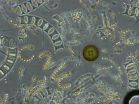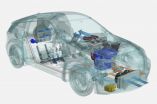(Press-News.org) PROVIDENCE, R.I. [Brown University] -- Researchers from Brown University and the University of Rhode Island have demonstrated a promising new way to increase the effectiveness of radiation in killing cancer cells.
The approach involves gold nanoparticles tethered to acid-seeking compounds called pHLIPs. The pHLIPs (pH low-insertion peptides) home in on high acidity of malignant cells, delivering their nanoparticle passengers straight to the cells' doorsteps. The nanoparticles then act as tiny antennas, focusing the energy of radiation in the area directly around the cancer cells.
In a paper published in the Proceedings of the National Academy of Sciences, the research team shows that the approach substantially increases the cancer-killing power of radiation in lab tests.
"This study was a good proof of concept," said Michael Antosh, assistant professor (research) in Brown's Institute for Brain and Neural Systems and the paper's lead author. "We're encouraged by our initial results and we're excited to take the next step and test this in mice."
The team is hopeful that the approach could ultimately improve radiation treatment for cancer patients. By increasing the effectiveness that a given dose of radiation has on cancer, the technique could reduce the overall radiation dose a patient requires, which would in turn reduce side effects. It could also increase the effectiveness of radiation at doses currently administered.
Special delivery
This research is an extension of work started by Yana Reshetnyak and Oleg Andreev, professors in the URI's Division of Biological and Medical Physics, and professor Donald Engelman of Yale University, the inventors of pHLIP technology. The URI/Yale team had previously developed pHLIPs as a potential delivery system for cancer drugs and diagnostic agents. Cancer cells are generally more acidic than healthy cells, and pHLIPs are natural acid-seekers.
"We previously demonstrated that pHLIP-nanogold particles could find and accumulate in tumors established in mice," Reshetnyak said. "Now our task is to test if we can treat cancer by irradiating tumors with nanogold particles more efficiently in comparison with traditional radiation treatment."
Both theoretical and experimental work had shown that gold nanoparticles could intensify the effect of radiation. The particles absorb up to 100 times more radiation than tissue. Radiation causes the particles to release a stream of electrons into the area around them. If the particles were in close proximity to cancer cells, that stream of electrons would inflict damage on those cells.
"The idea here was to bring this all together, combining the nanoparticles with the delivery system and then irradiating them to see if it had the desired effect," said Leon Cooper, the Thomas J. Watson Sr. Professor of Science at Brown and one of the study's co-authors. Cooper, who shared the Nobel Prize in 1972 for explaining the behavior of electrons in superconductors, has been working for the last several years to better understand biological responses to radiation.
Auger effect
Gold is an especially good choice for amplifying radiation. When matter is hit by radiation at certain energies, electrons are released through a process known as the photoelectric effect. But gold has an additional source of electron emission, known as the Auger effect, that results from the particular arrangement of electrons orbiting gold atoms. It's the effect of the Auger electrons that the researchers were working to maximize. Working out the quantitative details of the process involved complex calculations and simulations, Cooper said.
Auger electrons are low-energy and travel only a very short distance. Their travel distance is so short, in fact, that the electrons may not escape the nanoparticle if the particle is too large. So the researchers had to make sure their particles were small enough to emit those electrons. The short travel distance also means that particles need to be delivered in very close proximity to the cancer cells in order to do damage, hence the need for the pHLIPs.
Experiments showed that cancer cells irradiated in the presence of pHLIP-delivered gold had a 24-percent lower survival rate compared to those treated with radiation alone. The pHLIP samples had a 21-percent lower survival compared to irradiation with just gold but no pHLIPs. That suggests that the pHLIPs were effective in getting the gold close enough to the cells to do damage.
The next step, the researchers say, is to test the approach in a rodent model, which the team is planning to do soon.
"This work is a great example of successful collaboration between Brown and URI," Andreev said. "We hope that the results of this research moving forward will lead to clinical application of pHLIP-based nanotechnology."
INFORMATION:
Other authors on the study from URI were Dayanjali Wijesinghe, Samama Shrestha, and Natallia Katenka. Other authors from Brown were Robert Lanou, Yun Hu Huang, Thomas Hasselbacker, David Fox, and Shouheng Sun. The work was supported by the National Institutes of Health (grants 2 P20 GM103430, CA133890, and GM073857).
CORVALLIS, Ore. - Researchers at Oregon State University have discovered how vitamin E deficiency may cause neurological damage by interrupting a supply line of specific nutrients and robbing the brain of the "building blocks" it needs to maintain neuronal health.
The findings - in work done with zebrafish - were just published in the Journal of Lipid Research. The work was supported by the National Institutes of Health.
The research showed that zebrafish fed a diet deficient in vitamin E throughout their life had about 30 percent lower levels of DHA-PC, which is a ...
PITTSBURGH, April, 13, 2015 - A serendipitous combination of technology and scientific discovery, coupled with a hunch, allowed University of Pittsburgh Cancer Institute (UPCI) researchers to reveal a previously invisible biological process that may be implicated in the rapid growth of some cancers.
The project, funded by the National Institutes of Health (NIH), is described in today's issue of the Proceedings of the National Academy of Sciences (PNAS).
"I was so amazed by what I was seeing," said lead author Masahiro Shuda, Ph.D., research assistant professor in Pitt's ...
HOUSTON - (April 13, 2015) - For decades, scientists and physicians have puzzled over the fact that infants with the postnatal neurodevelopmental disorder Rett syndrome show symptoms of the disorder from one to two years after birth.
In a report in the Proceedings of the National Academy of Sciences, Dr. Huda Zoghbi and her colleagues from Baylor College of Medicine and the Jan and Dan Duncan Neurological Research Institute at Texas Children's Hospital, unravel the mystery by looking at when and how the causal gene involved (methyl-CpG binding protein 2 or MECP2) binds ...
Fresh insights into how bacteria protect themselves - by forming a waterproof raincoat - could help develop improved products to protect plants from disease.
Researchers have discovered how communities of beneficial bacteria form a waterproof coating on the roots of plants, to protect them from microbes that could potentially cause plant disease.
Their insights could lead to ways to control this shield and improve its efficiency, which could help curb the risk of unwanted infections in agricultural or garden plants, the team says.
Scientists at the Universities of ...
A new analysis of the chemical make-up of meteorites has helped scientists work out when the Earth formed its layers.
The research by an international team of scientists confirmed the Earth's first crust had formed around 4.5 billion years ago.
The team measured the amount of the rare elements hafnium and lutetium in the mineral zircon in a meteorite that originated early in the solar system.
"Meteorites that contain zircons are rare. We had been looking for an old meteorite with large zircons, about 50 microns long, that contained enough hafnium for precise analysis," ...
Diversity of life abounds on Earth, and there's no need to look any farther than the ocean's surface for proof. There are over 200,000 species of phytoplankton alone, and all of those species of microscopic marine plants that form the base of the marine food web need the same basic resources to grow--light and nutrients.
A study by a team of scientists from the Woods Hole Oceanographic Institution (WHOI), University of Rhode Island (URI), and Columbia University, published April 13 in the Proceedings of the National Academy of Sciences reveals how species of diatoms--one ...
ANN ARBOR, Mich. - One of the brain's main jobs is information processing - what is critical, however, is that information in the brain gets transferred to the right places at the right times.
Research on large-scale brain networks by the University of Michigan Medical School reveals that "hubs" in the brain - highly connected regions that like hubs of the airport system - tend to consistently attract information flow.
"Understanding how information transfer occurs in the brain is critical, especially if network hubs are taken off line by anesthesia, tumor or stroke," ...
This news release is available in German.
How can a pleasant vehicle climate be achieved efficiently? Researchers at the Technische Universität München (TUM) pursued this question in the context of the research project Visio.M funded by the German Federal Ministry for Education and Research (BMBF) with a total of 7.1 million euro. The results of their research show that the potential of energy efficient air conditioning is all but exhausted. And this applies also to gasoline powered cars.
Inefficiency has its advantages, too: In the past, waste heat ...
Researchers are beginning to explore whether the genetics of patients who experience a placebo effect are different from those of patients who don't. It's well known that people can feel better if they believe they are receiving treatment, but the biological pathways involved are relatively unexplored. In a new review, publishing April 13 in Trends in Molecular Medicine, scientists at Beth Israel Deaconess Medical Center discuss what we know as well as possible ethical issues related to conducting genetic tests to determine whether a patient is a placebo responder.
"Understanding ...
A new strategy to rule-out and rule-in heart attacks in emergency departments will help physicians treat patients faster, found a clinical trial published in CMAJ (Canadian Medical Association Journal).
Acute myocardial infarction (MI) is a common cause of death and disability around the world. Early diagnosis is critical for treatment and survival.
Swiss and Spanish researchers conducted a clinical trial to determine whether a new technique, previously tested in a small pilot study, would be effective in determining whether a patient has had a heart attack. They enrolled ...


